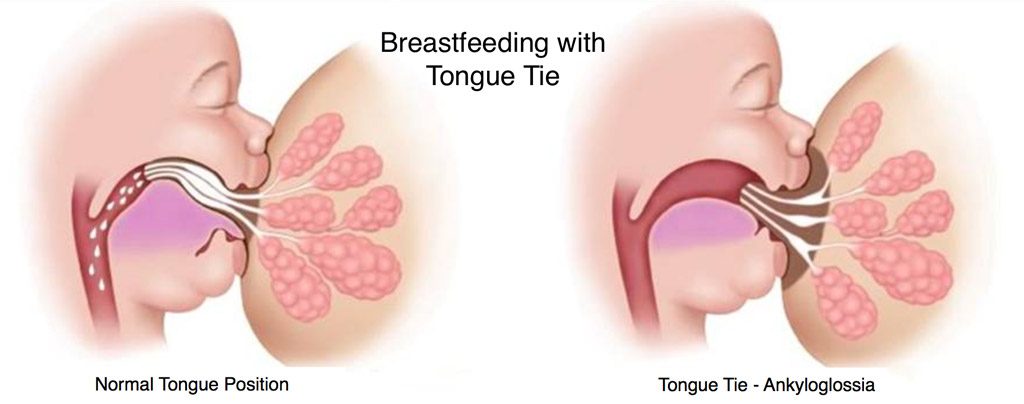What is a lip tie? | Causes | Symptoms | Diagnosis | How do I feed a baby with lip ties?
Lip ties can be a source of frustration for parents and breastfed infants alike.
Luckily, lip ties are relatively easy to diagnose and there is no shortage of treatment options available.
In this article, we will answer all your lip tie questions with in-depth information about what lip ties are, how they affect breastfeeding, and what you can do about it.
What is a lip tie?
A lip tie, also called a labial frenulum, occurs when the thin connective tissues, called a frenulum, is attached to your gums and is too stiff or thick.
This forms an obstruction just behind the upper or lower front teeth, which can prevent your newborn infant from opening their mouth wide enough for a proper latch and breastfeeding.
Newborn babies with lip ties may also have difficulty moving their tongues or sticking out their tongues.
Some lip ties can be misdiagnosed as tongue-ties, which is why it’s important to get a proper diagnosis from an experienced professional.
What causes lip ties?
Contrary to what some believe, lip and tongue ties are not caused by anything the mother does or fails to do during pregnancy.
The chances of your child having a lip or tongue tie are the same regardless of how you gave birth, whether it was a vaginal delivery or a cesarean section.
The lip and/or tongue ties occur because they are present at birth, meaning a congenital condition, which means that your child is born with them.
What are the symptoms of lip ties?
It can be difficult to diagnose lip ties because the symptoms are not specific; however, most women will have breastfeeding issues.
Some common lip tie symptoms for the breastfeeding infant include:
- trouble latching onto the breast or bottle
- gagging, choking, food coming out of the nose while eating
- clicking noises made by your child during breastfeeding due to the inability to latch onto the nipple
- feeding frequently, also known as cluster feeding
- gaining weight for the child is a problem
- jaundice, where the child’s skin and possibly eyes turn yellow
The child is not the only person who can have symptoms of lip ties as it can affect the mother too. Common symptoms for mothers of breastfeeding children with lip ties include:
- maternal nipple pain and crackling sensation during breastfeeding
- damage and distortion to the mother’s nipple
- engorged breasts
- blocked milk ducts which are also called mastitis
- too much or too little milk supply
As you can see, lip ties can cause problems for both the mother and the child so it is important to get them diagnosed to help your child with successful breastfeeding.
How are lip ties diagnosed?
Currently, lip ties can be diagnosed by a visual inspection of the inside of your child’s mouth.
In order to do this properly, you must have someone who is very experienced with lip and tongue tie diagnosis look at your baby’s mouth.
The medical professionals that most commonly diagnose lip ties are your baby’s doctor, a lactation expert (or breastfeeding expert), and dentists.
It should be noted that there are four levels of severity when it comes to lip ties and they are ranked from level one being the least severe lip ties to level four lip ties being the most serious.
These levels are:
- level one is mucosal meaning it is only attached to the skin
- level two is gingival meaning the frenulum is attached to the gums
- level three is papillary meaning it extends further into the gums where the teeth can develop
- level four is papilla penetrating meaning it is attached even deeper than the papillary
What’s the difference between lip ties and tongue-ties?
People often think that lip ties are similar to tongue ties, which are also called ankyloglossia or a lingual frenulum, but there is a big difference between these two conditions.
A lip tie only affects the lips, both the top and bottom lips, while children with tongue ties have a frenulum from the bottom of their tongue to the bottom of their mouth.
If a lip tie is only on the top lip, it’s called a unilateral lip tie while if your child has both their upper and lower lip ties, they have bilateral lip ties.
How do I know if my child has a lip tie?
One of the best ways to determine whether or not your baby has a lip and/or tongue-ties is by looking at their tongues while breastfeeding.
If you notice that your infant’s tongue is either completely stuck to the roof of their mouth or that they have a heart-shaped tongue, then it’s likely that your child has a lip and/or tongue-ties.
Another way you can determine whether or not your child has lip ties is by looking inside your baby’s mouth yourself.
If you see a lip tie, it will be a skin-colored band of tissue running across the inside of your child’s mouth. If you are unsure whether or not your child has lip ties, you can always take a picture of their mouth and show it to someone who is experienced with lip tie diagnosis.
How do I feed a baby with lip ties?
Feeding infants who have lip and/or tongue-ties can be very difficult because they are unable to grasp the nipple properly which makes it more challenging for them to learn how to breastfeed.
One of the best ways to feed your baby with lip ties is by using a nipple shield, however, there are some important things you need to be aware of before you start feeding your child this way.
Firstly, it can take some time for both you and your baby to learn how to use the nipple shield without any issues which can be frustrating.
Secondly, the nipple shield will not solve all of your lip-tied baby’s problems while breastfeeding because even if they are able to latch on properly with the nipple shield it still doesn’t allow them to get a good seal around the base of their tongue and thus won’t help them transfer of milk efficiently. That being said, nipple shields do help with the reduction in nipple pain for the mother.
You may also want to try bottle feeding as another alternative to breastfeeding if your lip-tied baby is having difficulty latching.
While bottle feeding doesn’t allow you and your child to bond in the same way as breastfeeding, bottle feeding can be helpful if your lip-tied baby is having a hard time latching on and transferring breast milk.
If these methods still do not work, we recommend talking to a lactation expert or doctor for more ideas.

What are some ways to fix a lip tie?
There are typically two different ways lip ties can be fixed and both require surgical intervention. Both surgical treatments are called are a frenectomy or more specifically a labial frenectomy, meaning the removal of the lip tie.
The first way is by cutting the lip tie using special surgical scissors or instruments.
A second option for fixing lip-ties is by a laser treatment where the doctor will use an intense light beam to separate your child’s lip from their gum tissue and then cauterize the wound which stops it from bleeding profusely.
Lip tie laser surgery is also called a laser frenectomy. Typically local anesthesia is used for the frenectomy using surgical instruments while no anesthesia is necessary when performing laser surgery.
Summary
Lip ties are thin pieces of tissue that connect in the middle of the lips to the gums and they can be on both the upper and lower lips.
The symptoms vary, but most mothers notice their child may have a lip tie due to breastfeeding difficulties.
The child will have trouble latching onto the breast, feeding, and may even make a clicking noise due to this difficulty among other symptoms.
Some of the most common symptoms for the mother include nipple pain and nipple distortion.
Lip ties are usually easily diagnosed by a medical professional by observing the child’s lips. Lip ties are similar to tongue ties in that they are both thin pieces of tissue; however, lip ties attach from the gums to the lips while tongue ties attach from the bottom of your tongue to the bottom of your mouth.
To feed a baby with a lip tie, you can try using a nipple shield or bottle feeding and if these don’t work you can always consult your doctor or a lactation expert.
There are two surgical procedures that doctors and dentists use to fix lip ties.
The first procedure involves cutting the lip tie using surgical equipment while the second method cuts the lip tie using a laser and both are very effective.
If you think your child has a lip tie or you are having difficulty breastfeeding, we recommend talking to your doctor or healthcare provider about whether any procedure will be necessary or to figure out a method for improved breastfeeding effectiveness.
References, Studies and Sources:

Bridget Reed is a Tampa-based content development manager, writer, and editor at GR0; specializing in content related to varying fields including medicine, health, and small businesses. Bridget went to St. Petersburg College and majored in Management and Organizational Leadership.
Recent Publications: Body Acne 101: Prevention and Treatment, Stress Acne: Causes, Prevention, and Treatment, What are the Side Effects of Midol?
